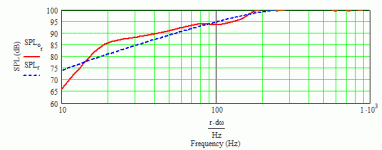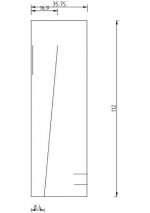00600 said:
here's a link to the .xls file I used:
You're welcome!
LOL! I should have known! Long story short, this is what I call a ML -horn calculator that's based on some very erroneous rules-of-thumb, so the best thing you can do with it is to send it to the trash bin IMO. MJK's various write-ups on designing these, TLs, the TQWTs I'm suggesting and simming them using his Mathcad software is accurate enough, so tuning is no more 'hit or miss' than using HR and if you use his 'Classic TL' design routine, then even easier/quicker: http://www.quarter-wave.com/
WRT 'flat response', a driver with a <0.2 Qts only has a maximally flat response down to ~150 Hz in 2pi space, so placing them along a wall (1pi) or in a corner (0.5pi) to boost it down low to allow a lower tuning for a better match with the room's modes is desirable. If you mean 'flat' within its pass-band, then the TQWT can be as flat as any other vented alignment as it's just a large/long vented BR taken to its logical extreme, i.e. morphed into a reverse tapered pipe.
Note that as a general rule-of-thumb, tuning a typical vented alignment below ~0.707*Fs isn't a good plan unless the driver is high Q (> ~0.403 Qts) and has enough Xmax, or ~22.5 Hz for this driver, though the high damping of TLs, etc., renders this mostly moot.
This driver should work well in horns if the specs are reasonably accurate, but will be quite long/large to go low with any authority.
Hmm, with only a single driver, getting 110 dB/20 Hz will require some serious room gain since the amount of power required to drive it to these levels would cause up to 6 dB of thermal power compression.
Right, the driver's low Qts makes it a poor choice for a LRT alignment unless the mains are very inefficient.
Anyway, here's a 10:1 CR TQWT in a ~6.49 ft^3 net cab using the assumption of a terminus area = dual 4" diameter vents that when mildly stuffed has an 18 Hz Fp in a single fold 4 ft. length assuming 0.75" thick construction:
L = 94.5"
SO = 251.3"^2
SL = 25.13"^2
zdriver (offset) = 9"
zport = near/at the end
stuffing density = 0.25 lbs/ft^3 of polyfil
If you load it into HR, you'll see a much less flat response with a ~20 Hz Fp since it doesn't account for the effects of stuffing.
GM
Attachments
GM said:
Anyway, here's a 10:1 CR TQWT in a ~6.49 ft^3 net cab using the assumption of a terminus area = dual 4" diameter vents that when mildly stuffed has an 18 Hz Fp in a single fold 4 ft. length assuming 0.75" thick construction:
L = 94.5"
SO = 251.3"^2
SL = 25.13"^2
zdriver (offset) = 9"
zport = near/at the end
stuffing density = 0.25 lbs/ft^3 of polyfil
If you load it into HR, you'll see a much less flat response with a ~20 Hz Fp since it doesn't account for the effects of stuffing.
GM
So That would be 94.5" long along the centerline, 25.13sqin closed end, with the driver offset 9"from the closed end (that's going to be tough, have to reverse mount it), 251.3sqin open end, with .25lbcuft of stuffing (throughout or just the 1/3 of the pipe from the closed end?).
Would it better to slot port it (same as driver sd?), or to run the 4" ports? It seems like the required length of the ports would seriously disrupt wave formation.
00600 said:group delay
Sorry to interrupt, but looking at the group delay graph, you actually get much lower group delay with the 18 Hz tuning in the 25Hz and above range, until you get near to the tuning frequency and the group delay shoots up.
Is group delay more audible than phase? Actually what is the difference?
A well designed subwoofer that integrates well with the mains has a characteristic and natural 'tight' sound with good 'snap' and 'attack'. Is it because of low group delay or good phase matching?
00600, Sorry didn't mean to change topic or hijack thread.
00600 said:
So That would be 94.5" long along the centerline, 25.13sqin closed end, with the driver offset 9"from the closed end (that's going to be tough, have to reverse mount it), 251.3sqin open end, with .25lbcuft of stuffing (throughout or just the 1/3 of the pipe from the closed end?).
Would it better to slot port it (same as driver sd?), or to run the 4" ports? It seems like the required length of the ports would seriously disrupt wave formation.
Right.
The closed end (SO) = 251.3"^2, plenty of room to mount the driver normally. Note that the 9" is flexible, I just picked it since the driver's nominally 18", so if you want/need to shift it a little for an easy fit/whatever it's not a problem. The main thing is that the driver and terminus (vent opening) is near/at the floor for max boundary coupling, zero 'floor bounce'.
The sim assumes the stuffing density is uniform the whole length of the TQWT. Stuffing is a tuning tweak though, so I recommend experimenting with less to begin with to find the best in-room tonal balance Vs a seamless blend to the mains.
??? This is a reverse tapered pipe, i.e. the whole cab is effectively one big, long tapered port tube, ergo the actual 'port' will be just a 25.13"^2 cutout at the small end (SL).
GM
rhapsodee said:
Sorry to interrupt, but looking at the group delay graph, you actually get much lower group delay with the 18 Hz tuning in the 25Hz and above range, until you get near to the tuning frequency and the group delay shoots up.
Is group delay more audible than phase? Actually what is the difference?
A well designed subwoofer that integrates well with the mains has a characteristic and natural 'tight' sound with good 'snap' and 'attack'. Is it because of low group delay or good phase matching?
00600, Sorry didn't mean to change topic or hijack thread.
No apology necessary. You answered one of my questions. And it makes perfect sense.
I understand group delay as in the time difference between the signal reaching the driver, and the sound reaching your ear. IE: the first harmonic, say a 30hz tone from the sub reaching you within the proper time frame to match up with say the 6th harmonic (180hz) so that the "note" sounds natural.
But I don't understand how to read the graph.
GM said:
Right.
The closed end (SO) = 251.3"^2, plenty of room to mount the driver normally. Note that the 9" is flexible, I just picked it since the driver's nominally 18", so if you want/need to shift it a little for an easy fit/whatever it's not a problem. The main thing is that the driver and terminus (vent opening) is near/at the floor for max boundary coupling, zero 'floor bounce'.
The sim assumes the stuffing density is uniform the whole length of the TQWT. Stuffing is a tuning tweak though, so I recommend experimenting with less to begin with to find the best in-room tonal balance Vs a seamless blend to the mains.
??? This is a reverse tapered pipe, i.e. the whole cab is effectively one big, long tapered port tube, ergo the actual 'port' will be just a 25.13"^2 cutout at the small end (SL).
GM
Ahh, I had the SL and SO confused. I was thinking something along the lines of this:
Attachments
rhapsodee said:
.......you actually get much lower group delay with the 18 Hz tuning in the 25Hz and above........
Is group delay more audible than phase? Actually what is the difference?
A well designed subwoofer that integrates well with the mains has a characteristic and natural 'tight' sound with good 'snap' and 'attack'. Is it because of low group delay or good phase matching?
Right, the lower the tuning, the greater the group delay, but the quicker it decays and why I prefer low tuned EBS alignments since the group delay is as good (and sometimes better) than a sealed alignment except with more gain BW.
Group delay is the negative derivative of the phase WRT frequency. IOW, GD just tells us how fast the phase changes WRT frequency, so its just two ways to display acoustic phase rotation. Since our hearing acuity falls off with decreasing and increasing frequency below/above our critical hearing BW, the answer is it depends on the individual person's hearing acuity, all else being equal.
Really, a ~flat in-room frequency response typically is the most important criteria to getting a good blend down low, another reason I prefer the low tuned EBS if only one or two subs is used.
GM
- Status
- This old topic is closed. If you want to reopen this topic, contact a moderator using the "Report Post" button.
- Home
- Loudspeakers
- Subwoofers
- Tuning BR below Fs?


